
Original Link: https://www.anandtech.com/show/402
Budget Video Comparison - November 1999
by Mike Andrawes on November 1, 1999 10:05 PM EST- Posted in
- GPUs
Introduction
The fact that the latest technology doesn’t remain that way for more than 6 months can be quite annoying to the cost conscious buyer, but it does have an upside. The fact is that today it’s easy to find an excellent 2D/3D accelerator at a price that would have only provided adequate performance not too long ago.
However, with all the talk of GeForce this, Voodoo4 that, it’s easy to feel left out if you can’t afford to buy the latest and greatest every few months. Rest assured that AnandTech has not forgotten you – we know exactly how you feel. That’s why we’re here today rounding up the best video cards out there for under $100.
These budget video cards have been instrumental in the OEM market where cost
is key. Everybody is hopping into this market, even the usual performance leaders,
3dfx and NVIDIA, who have traditionally focused on the high end. Quite simply,
the OEM’s mean volume, so success in this market is critical to a company’s
survival.
Case in point – while the Savage4 may not have been praised so highly by hardcore gamers, it garnered a tremendous number of OEM wins, including the likes of IBM, Compaq, NEC, and many others.
What’s all this OEM talk mean for the general consumer? More options and cheaper cards that are better on the low end then ever before are now available. But remember, since many of these cards are targeted at OEM’s, you may not be able to find them in retail boxes at your local Best Buy. Rather, you’ll probably have to order it online or get it from a local shop that builds custom PC’s.
All the cards we’ll be looking at today are fully featured 3D accelerators that will more than adequately play any game on the market today. The big question is "which one does it best?" That’s what AnandTech is for, so let’s get started.
The Contenders
As we’ve noted before, the chipset on a graphics card is the primary factor influencing performance. There are differences between cards based on the same chipset, but these differences are miniscule compared to the difference between chipsets. Thus, our focus is on the available chipsets. Let’s see what we have here…
3dfx Velocity 100
The 3dfx Velocity 100 is 3dfx’s latest entry into the market and is definitely targeted at OEM’s and value conscious buyers. Check out our complete 3dfx Velocity 100 Review for full details on this card. We basically found that, with a registry hack, it provided most of the features of the Voodoo3 2000, but at $50, it’s almost half the price. The Velocity is only available as an AGP card.
3dfx Voodoo 2
We’re going way back for the Voodoo2 – the former champ of the 3D world is still a potential option for a budget system. After all, you can pick these guys up for around $30 with some careful looking – a quick and easy way to get your 3D fix.
In case you don’t remember, the Voodoo2 is a 3D only PCI card that works with your existing 2D or 2D/3D graphics card. A pass through cable is used to Two cards can be linked together via a technique known as "Scan Line Interleaving," or SLI for short, where each card renders alternative scan lines of an image, theoretically doubling performance.
3dfx Voodoo3 2000
Thanks to the continually falling prices of computer hardware, the Voodoo3 2000 is also a good pick for a budget card. It does come in at the high end of the price range for this article - around $100. Available in both PCI and AGP form, the Voodoo3 2000 should be easy to find at any retail outlet. OEM versions are also available without the game bundle and at an even lower price. AnandTech’s Voodoo3 review has the complete details.
Notes on 3dfx cards
3dfx has yet to release a card that supports 32-bit rendering, texture sizes greater than 256x256, or AGP texturing. Up until recently, this was not considered a huge limitation by most gamers out there, especially since 3dfx was faster with their 16-bit rendering. However, games like Quake3 Arena, as well as a number of other upcoming titles, are really beginning to expose the drawbacks to 16-bit rendering and the limited texture size. Although we’ve been saying it since the arrival of AGP, games with lots and lots of textures, and thus benefiting greatly by AGP texturing, should begin showing up by the end of this year.
Image quality is similar among the 3dfx cards since the 3D core is virtually identical. However, the Voodoo3/Velocity do have some advanced filtering capabilities in their drivers that help minimize dithering artifacts that arise due to multi-pass 16-bit rendering. Further, both the Velocity and Voodoo3 feature a full 128-bit memory bus, unlike the rest of the cards in this roundup. Finally, 3dfx cards also support the Glide, a proprietary API developed and controlled by 3dfx. Glide support is becoming less and less of a factor
NVIDIA TNT2 M64
NVIDIA has taken a different approach to the value conscious market. Their TNT2 M64 chip has all the features of a regular TNT2, but cuts cost with the use of a 64-bit memory interface instead of the TNT2’s 128-bit. This comes into play mainly at higher resolutions and color depths. The fact that the 3D core is the same means you still get 32-bit rendering support, full AGP texturing support, and support for texture sizes up to 2048x2048. The chip itself even supports AGP 4X, although not every board manufacturer has implemented the feature.
At around $80 for a 16MB card and $95 for a 32MB card, the M64 comes in at the upper end of our price range. This puts it at a slight disadvantage, as other cards in this range simply have more raw power. The TNT2 M64 is generally only available in OEM "white box" packaging. However, nearly every manufacturer with a TNT2 in its line up also has the M64. The M64 is currently only available in AGP form.
Check out AnandTech’s complete TNT2 M64 review for further details.
S3 Savage 4 Pro+
Just like the Savage3D, the Savage 4 look to be a very promising part when it was announced. But once again, it was plagued by driver issues and performance that was lower than expected. Fortunately, S3 seems to have sorted out the majority of the issues and tweaked performance significantly with driver updates.
The Pro+ was the high-end of the Savage 4 line when it was released, but now
is the most commonly used model. The Pro+ is clocked at 125/143, putting it
very close to the TNT2 M64 in terms of raw power. All Savage 4’s feature a 64-bit
memory bus, 32-bit rendering support, AGP texturing, and 2048x2048 texture support.
Don’t forget to read AnandTech’s complete Savage 4 review for the full story.
S3 Savage 4 Xtreme
The Savage 4 Xtreme is the same chip as the Savage 4 Pro+ with a higher clock speed. Thanks to the Diamond/S3 merger, this chip is currently only available on the Diamond Stealth III S540 Xtreme. The Stealth III S540 Xtreme is one example where there is a substantial difference between retail and OEM cards. The retail is clocked at 166/166, while the OEM is 143/166.
Other manufacturers have talked about releasing a Savage4 Xtreme product of their own, but we have yet to see any. These cards are coming in right around $100 with 32MB onboard, making them the most expensive cards in this roundup. With a core clock of 166 MHz for the retail version, the Savage 4 Xtreme has the most raw power of the cards here.
Image Quality
As far as 2D image quality goes, the Voodoo3 and Velocity 100 cards are both top notch. For the TNT2 M64 and the Savage 4 line, 2D image quality is a little harder to determine as it depends greatly on the individual manufacturers greatly. The TNT2 M64 cards are generally done quite well, while the Savage 4 Pro + is a bit below for resolutions in the 1600x1200 range. Diamond has generally been known for producing cards with excellent 2D image quality, and their Savage 4 Xtreme card is no different. However, be sure to check out individual card reviews to get full details on a specific card’s 2D image quality.
When it comes to 3D, things are a little more clear cut. 3dfx has yet to produce a chip that supports 32-bit rendering or texture sizes greater than 256x256. Granted, 3dfx has arguably the best 16-bit rendering out there using the latest set of drivers, but it’s still not as good as other cards’ 32-bit. The TNT2 M64 and Savage 4 line of course have full support for 32-bit rendering and 2048x2048 textures. Further, the Savage 4 also features S3 Texture Compression, which is finally becoming a reality in a number of games coming this holiday season. S3TC encourages the use of high resolution textures by minimizing the storage requirements for these textures.
Feature Comparison
|
AnandTech Video Chipset Feature Comparison Chart |
||||||
|
- |
- | |||||
| 3Dfx |
NVIDIA |
S3 Savage 4 | ||||
| Voodoo3 2000 |
Velocity 100 |
Voodoo2 | Pro+ | Xtreme | ||
|
Type |
||||||
| Standalone 3D | - | - | - | - | - | |
| 2D/3D | - | |||||
|
Interface Support |
||||||
| PCI 2.1 | - | - | - | |||
| AGP 2X | - | |||||
| AGP 4X | - | - | - | |||
| Rendering | ||||||
| 16bpp Color | ||||||
| 32bpp Color | - | - | - | |||
| Single Pass Multi-Texturing | ||||||
| Texture Compression | - | - | - | - | ||
| Maximum Texture Size | 256x256 | 256x256 | 256x256 | 2048x2048 | 2048x2048 | 2048x2048 |
| Clock Speed (core/memory) | 143/143 | 143/143 | 90/100 | 125/150 | 125/143 | 166/166 |
| Fillrate (Mtexels/s) | 286 | 286* | 180 | 250 | 250 | 333 |
| API Support | ||||||
| Direct3D | ||||||
| OpenGL ICD | ||||||
| Glide | - | - | - | |||
* with 2nd TMU enabled via registry - see 3dfx Velocity 100 Review for details
The Test
|
Windows 98 SE Test System |
||
|
Hardware |
||
|
CPU(s) |
Intel Pentium III 450 |
AMD K6-2 450 |
| Motherboard | ABIT BH6 | Epox MVP3G-2 |
| Memory |
128MB PC133 Corsair SDRAM |
|
| Hard Drive |
Western Digital 8.4GB AC28400 UDMA/33 |
|
| CDROM |
Kenwood 40X TrueX |
|
| Video Cards |
3dfx Velocity 100 8MB SGRAM (default
clock - 143/143) |
|
|
Software |
||
|
Operating System |
Windows 98 SE |
|
| Video Drivers |
Matrox Millenium G400 5.25 with
Beta TurboGL |
|
|
Benchmarking Applications |
||
| 2D Graphics |
ZDBop
Graphics Winbench 99
|
|
| Gaming |
id Software Quake 3 Test 1.08
(OpenGL) |
|
Pentium III 450 OpenGL Performance
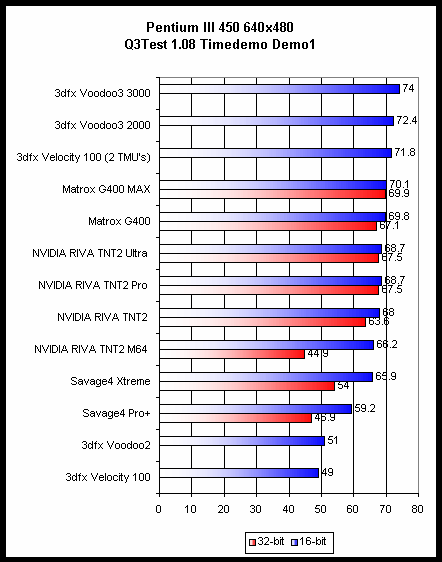

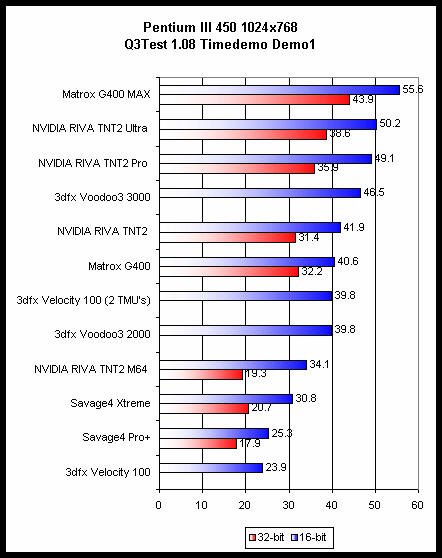
Celeron 450A OpenGL Performance
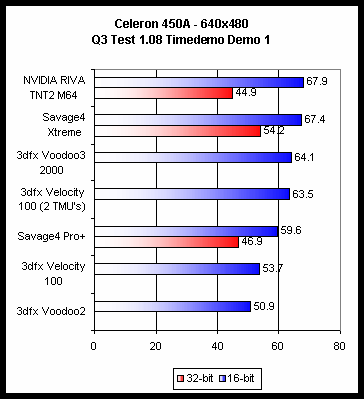
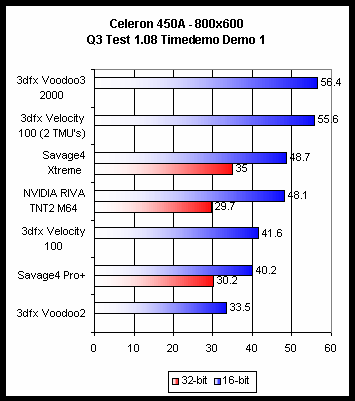
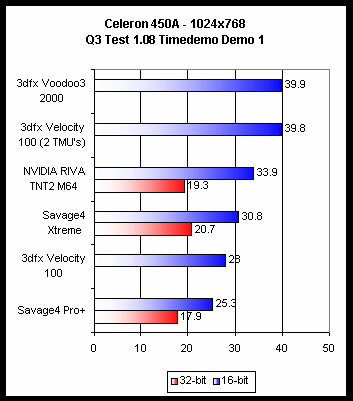
Celeron 300A OpenGL Performance
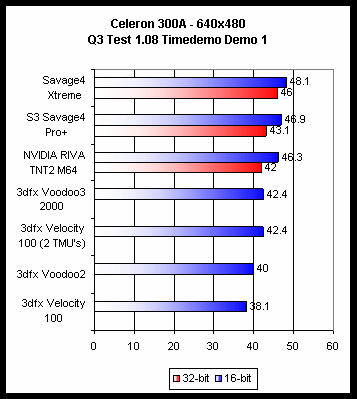


AMD K6-2/450 OpenGL Performance
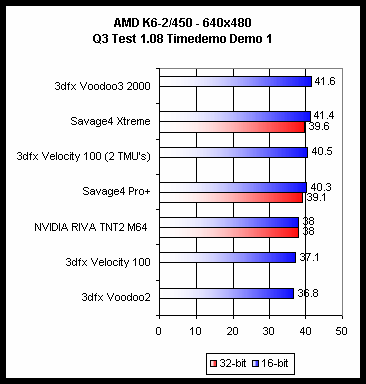
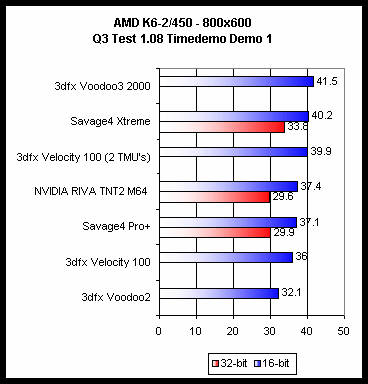
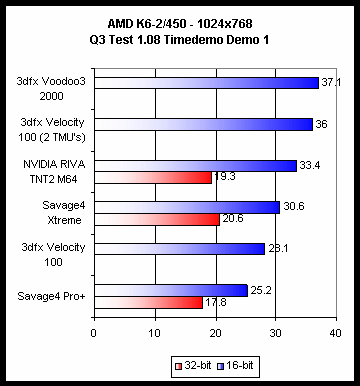
Pentium III 450 Direct3D Performance

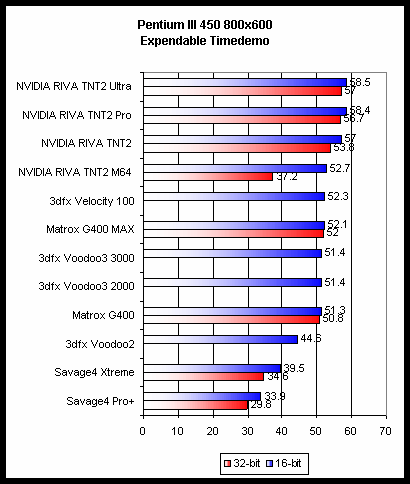
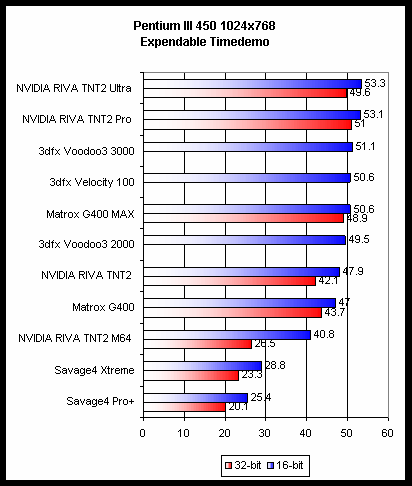
Celeron 450A Direct3D Performance
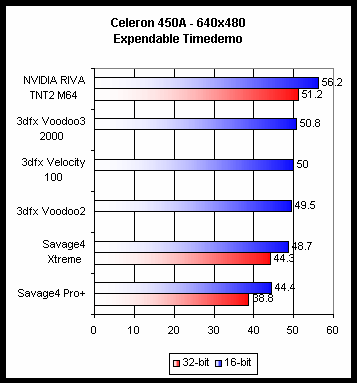
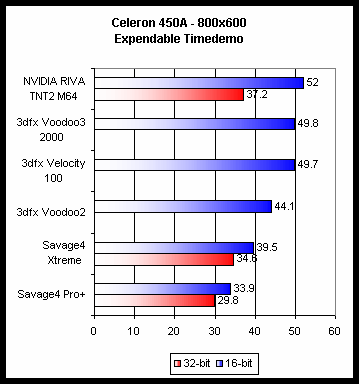
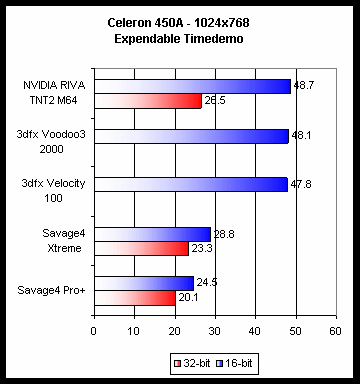
Celeron 300A Direct3D Performance
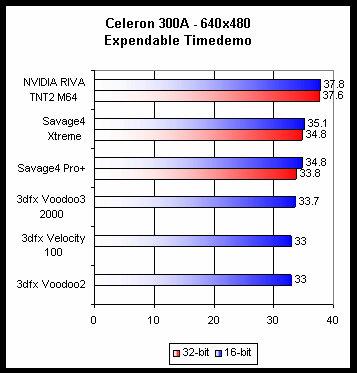
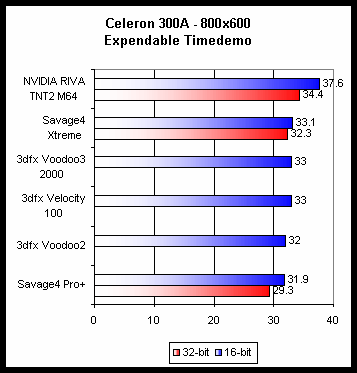
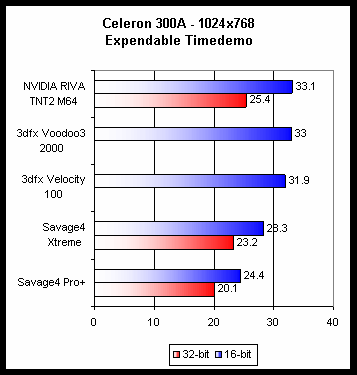
AMD K6-2/450 Direct3D Performance
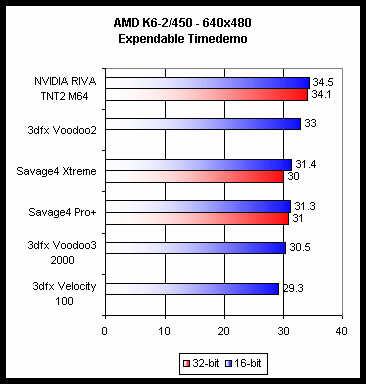
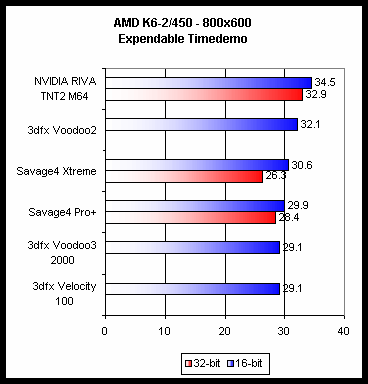
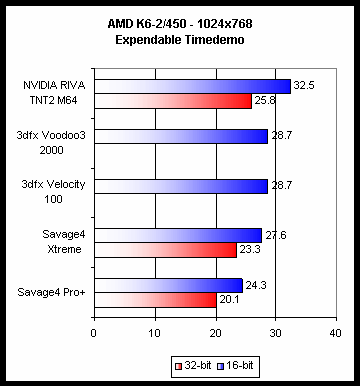
Performance Analysis
With the Celeron 300A, the Voodoo3 2000 takes the OpenGL performance crown at higher resolutions, do largely to its full 128-bit memory bus. However, at lower resolutions, the Savage4 Xtreme with the Savage4 Pro+ and TNT2 M64 bunched up just behind it. Note that the performance difference among the cards at low resolution is minimal because performance is CPU limited under these circumstances. Direct3D Expendable results are similar, with the TNT2 M64 taking the lead under all resolutions.
Overclocking that same Celeron to 450 MHz yields a slightly different outcome. The Voodoo3 is still the king at high resolutions, but at lower resolutions, performance differences become much more apparent. The M64 takes a slight lead over the Savage 4 Xtreme under these circumstances, while the Savage 4 Pro+ falls way back. It’s interesting to note that the only card that the Savage 4 Xtreme and Pro+ can beat out at 1024x768 is the Velocity with only 1 TMU enabled. Under Direct3D, the M64 again jumps into the lead at every resolution, while the Savage 4 line falls far behind as the resolution is pushed up. The Voodoo3 2000 and Velocity 100 are a close second.
Note that under every CPU, resolution, and benchmark combination, the Velocity 100 with both TMU’s enabled performs nearly identically to the Voodoo3 2000. To learn how to enable that TMU, read AnandTech’s 3dfx Velocity 100 Review. This is only required under OpenGL / Glide, as both TMU’s are already enabled under Direct3D.
Both the Savage 4 series and the TNT2 M64 support 32-bit rendering, but incur a large performance penalty due to their 64-bit memory bus that greatly limits memory bandwidth. This puts frame rates a bit low at 800x600, and in the unplayable range at 1024x768. The Savage 4 Xtreme outshines the M64 in this area under OpenGL, but again falls behind in Direct3D.
The venerable Voodoo2 hangs in there pretty well for such an old chipset, but has been surpassed by newer cards in almost all aspects. If your CPU is from Intel and runs at 300 MHz or above, there’s no reason to go for a Voodoo2. If you’ve already got a single Voodoo2, adding another one may be the best way to boost your performance at a relatively low price. If your CPU is slower than 300 MHz or a K6-2, the Voodoo2 may be a good match for a quick 3D fix, but a CPU upgrade should be seriously considered before moving on to a higher performing 3D card.
K6-2 systems actually seem to perform better with the Voodoo2 under Direct3D than with other 3dfx cards, falling only behind the TNT2 M64. This possibly hints at better 3DNow! optimizations in the Voodoo2 drivers compared with the Voodoo3.
Although we’ve reached a point now where 2D performance is not a major bottleneck, we’ve included 2D Winbench 99 scores for those that are interested. However, any of these cards will provide more than adequete performance. It is interesting to note the Velocity’s 2D performance is a good bit slower than the Voodoo3, although the cards appear to be identical in every other respect.
Conclusion
 After
running all the benchmarks, it appears that the surprising winner of the prestigious
AnandTech Editor’s Choice Gold award is the 3dfx Velocity. At just $50, the
only thing cheaper is the Voodoo2, which requires a separate 2D card and is
not as fast. For most people, the Velocity provides everything that the Voodoo3
2000 does at almost half the price. Like the Voodoo3, the Velocity doesn’t feature
32-bit rendering, AGP texturing, or large texture support. But it will cost
you up to twice as much to get those features and those cards are still slower.
After
running all the benchmarks, it appears that the surprising winner of the prestigious
AnandTech Editor’s Choice Gold award is the 3dfx Velocity. At just $50, the
only thing cheaper is the Voodoo2, which requires a separate 2D card and is
not as fast. For most people, the Velocity provides everything that the Voodoo3
2000 does at almost half the price. Like the Voodoo3, the Velocity doesn’t feature
32-bit rendering, AGP texturing, or large texture support. But it will cost
you up to twice as much to get those features and those cards are still slower.
The TNT2 M64 and Savage 4 Xtreme are both also excellent cards with performance just a bit lower than the Velocity 100. However, those cards will cost you nearly twice as much. Further, the performance hit caused by going to 32-bit on either of these cards is fairly large due to the 64-bit memory bus. The Savage 4 Xtreme does outshine the M64 in this area, even though its 16-bit performance is lower.
The TNT2 M64 can also be had with 16MB of memory for $80. Since the 64-bit memory bus of the M64 will be more of a bottleneck than the lower memory count anyway, this really isn’t such a bad deal.
So if you must have support for 32-bit rendering, AGP texturing, and 2048x2048 textures, the call comes down to the Savage 4 Xtreme or the TNT2 M64. The Savage 4 Xtreme is slightly faster, but the TNT2 M64 is cheaper and NVIDIA typically has a better track record for driver support.
For CPU’s in the 300 MHz range, performance is limited more by the CPU than the graphics card. As such, the Savage 4 Pro + is also a viable option, and even the Voodoo2 is reasonable at 640x480. A CPU upgrade will be more beneficial than a video card upgrade in these systems.
If you don’t absolutely need these features, the Velocity 100 is definitely your best bet out of this bunch. This is one case where you get more than you pay for.







